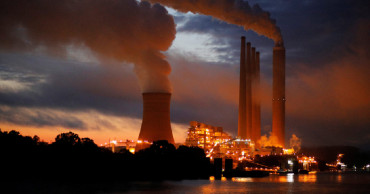WMO
Extreme weather kills 2 million, costs $4 trillion in 50 years: WMO
Extreme weather events accelerated by man-made global warming caused 11 778 reported disasters in the last 50 years, with just over 2 million deaths and US$ 4.3 trillion in economic losses, the World Meteorological Organization (WMO) has said.
Asia saw the highest death toll due to extreme weather, climate and water-related events during the period, with around one million deaths – more than half in Bangladesh alone.
Also Read: Heat wave in Asia made 30 times more likely because of climate change, scientists say
Developing countries were hit hardest, seeing nine in 10 deaths and 60 per cent of economic losses from climate shocks and extreme weather, it said on Monday.
Weather, climate and water-related hazards caused close to 12,000 disasters between 1970 and 2021, according to WMO findings.
Also Read: The US leads the world in weather catastrophes. Here’s why
WMO said that Least Developed Countries and Small Island Developing States suffered a “disproportionately” high cost in relation to the size of their economies.
“The most vulnerable communities, unfortunately, bear the brunt of weather, climate and water-related hazards,” said WMO Secretary-General Petteri Taalas.
In Least Developed Countries, WMO said that several disasters over the past half-century had caused economic losses of up to 30 per cent of gross domestic product (GDP).
Also Read: Italy’s deadly floods just latest example of climate change’s all-or-nothing weather extremes
In Small Island Developing States, one in five disasters had an impact “equivalent to more than five per cent” of GDP, with some disasters wiping out countries’ entire GDP.
In Africa, WMO said that droughts accounted for 95 per cent of the reported 733,585 climate disaster deaths.
Also Read: Pacific Island leaders say rich countries are not doing enough to control climate change
WMO stressed however that improved early warnings and coordinated disaster management have helped mitigate the deadly impact of disasters. “Early warnings save lives,” Taalas insisted.
The UN agency also noted that recorded deaths for 2020 and 2021 were lower than the previous decade’s average.
Pointing to the example of last week’s severe cyclonic storm Mocha, which caused devastation in Myanmar’s and Bangladesh’s coastal areas, Taalas recalled that similar weather disasters in the past caused “death tolls of tens and even hundreds of thousands” in both countries.
The agency had previously shown that just 24 hours’ notice prior to an impending weather hazard can cut the ensuing damage by 30 per cent, calling early warnings the “low-hanging fruit” of climate change adaptation because of their tenfold return on investment.
Also Read: Asia and the Pacific unprepared to face climate-induced catastrophes, warns new UN study
WMO issued its new findings on the human and economic cost of weather-induced disasters for its quadrennial World Meteorological Congress, which opened on Monday in Geneva with a focus on implementing the UN’s Early Warnings for All initiative.
Also Read: Scientists: Climate change worsened Eastern Africa drought
The initiative aims to ensure that early warning services reach everyone on Earth by the end of 2027. It was launched by UN Secretary-General António Guterres at the COP27 climate change conference in Sharm al-Sheikh in November last year.
Also Read: Asia must quit coal faster to stem worst climate woes: ADB
Currently, only half of the world is covered by early warning systems, with Small Island Developing States and Least Developed Countries left far behind.
2 years ago
Extreme heatwave batters millions in India, Pakistan
With India and Pakistan reeling under an extreme heatwave, the countries are working to roll out life-saving health action plans, the UN weather agency has said.
The extreme heat is impacting hundreds of millions of people in one of the most densely populated parts of the world, threatening to damage whole ecosystems.
Working closely with health and disaster management agencies, the national meteorological and hydrological departments in both countries, plan to roll out heat health action plans, which have been successful in saving lives in the past few years, said the World Meteorological Organization (WMO) Friday.
Both India and Pakistan have successful heat-health early warning systems and action plans already in place, including those specially tailored for urban areas.
They reduce heat mortality and lessen the social impacts of extreme heat, including lost work productivity.
The India Meteorological Department said maximum temperatures reached 43-46°C in widespread areas on April 28, and this intense heat will continue until May 2.
Similar temperatures have also been seen in Pakistan, with daytime temperatures likely to be between 5°C and 8°C above normal in large swathes of the country, said the Pakistan Meteorological Department.
In the mountainous regions of Gilgit-Baltistan and Khyber Pakhtunkhwa, the unusual heat levels would accelerate snow and ice melt, with the possibility of triggering glacial lake floods or flash floods in vulnerable areas, it added.
Air quality has also deteriorated, and large swathes of land are at risk of fire outbreaks.
It is premature to attribute the extreme heat in India and Pakistan solely to climate change, said the WMO. "However, it is consistent with what we expect in a changing climate."
The Intergovernmental Panel on Climate Change, in its recent Sixth Assessment Report, said heatwaves and humid heat stress would be more intense and frequent in South Asia this century.
Also read: Deadly flooding, heatwaves in Europe, highlight urgency of climate action: WMO
The current heatwave was triggered by a high-pressure system and follows an extended period of above-average temperatures.
India recorded its warmest March on record, with an average maximum temperature of 33.1°C, or 1.86°C above the long-term average.
Pakistan also recorded its warmest March for at least the past 60 years, with several stations breaking March records.
In the pre-monsoon period, both India and Pakistan regularly experience excessively high temperatures, especially during May.
India has established a national framework for heat action plans through the national disaster management authority which coordinates a network of state disaster response agencies and city leaders, to prepare for soaring temperatures and ensure that everyone is aware of heatwave protocols.
The city of Ahmedabad in India was the first South Asian city to develop and implement a city-wide heat health adaptation, in 2013, after experiencing a devastating heatwave in 2010.
This successful approach was then expanded to 23 heatwave-prone states and serves to protect more than 130 cities and districts.
Pakistan has also made strides towards protecting public health from heat.
In the summer of 2015, a heatwave engulfed much of central and northwest India and eastern Pakistan and was directly or indirectly responsible for several thousand deaths.
The event acted as a wake-up call and led to the development and implementation of the Heat Action Plan in Karachi and other parts of Pakistan.
Typical plans make sure the targeted intervention is a right fit and designed for the heat vulnerable population of a city.
It first identifies the heat hotspots of the city, locates the vulnerable populations in these pockets, and assesses the nature and status of their vulnerability to extreme heat.
3 years ago
Ocean, climate, weather theme to mark World Met Day
Bangladesh will observe the World Meteorological Day on Tuesday with the theme "The Ocean, Our climate and Weather."
4 years ago
Don’t use weather as a basis to relax COVID-19 control measures: WMO
The current onset of warmer temperatures in the northern hemisphere, should not be used as a trigger to relax measures to halt the spread of coronavirus, the UN weather agency cautioned on Thursday.
4 years ago
Cyclone 'Burevi' forms over southwest Bay of Bengal
A deep depression over southwest Bay of Bengal and adjoining area has intensified into the cyclonic storm "Burevi."
5 years ago
International Lightning Awareness Day today
The International Lightning Awareness Day is being observed across the world on Sunday.
5 years ago
Greenhouse gas emission hits record high: WMO
Record amount of the three main heat-trapping gases– carbon dioxide (CO2), methane, and nitrous oxide – emitted into the atmosphere in 2018, according to a report from the UN’s World Meteorological Organization.
6 years ago

.jpg)
.jpg)


.jpg)



